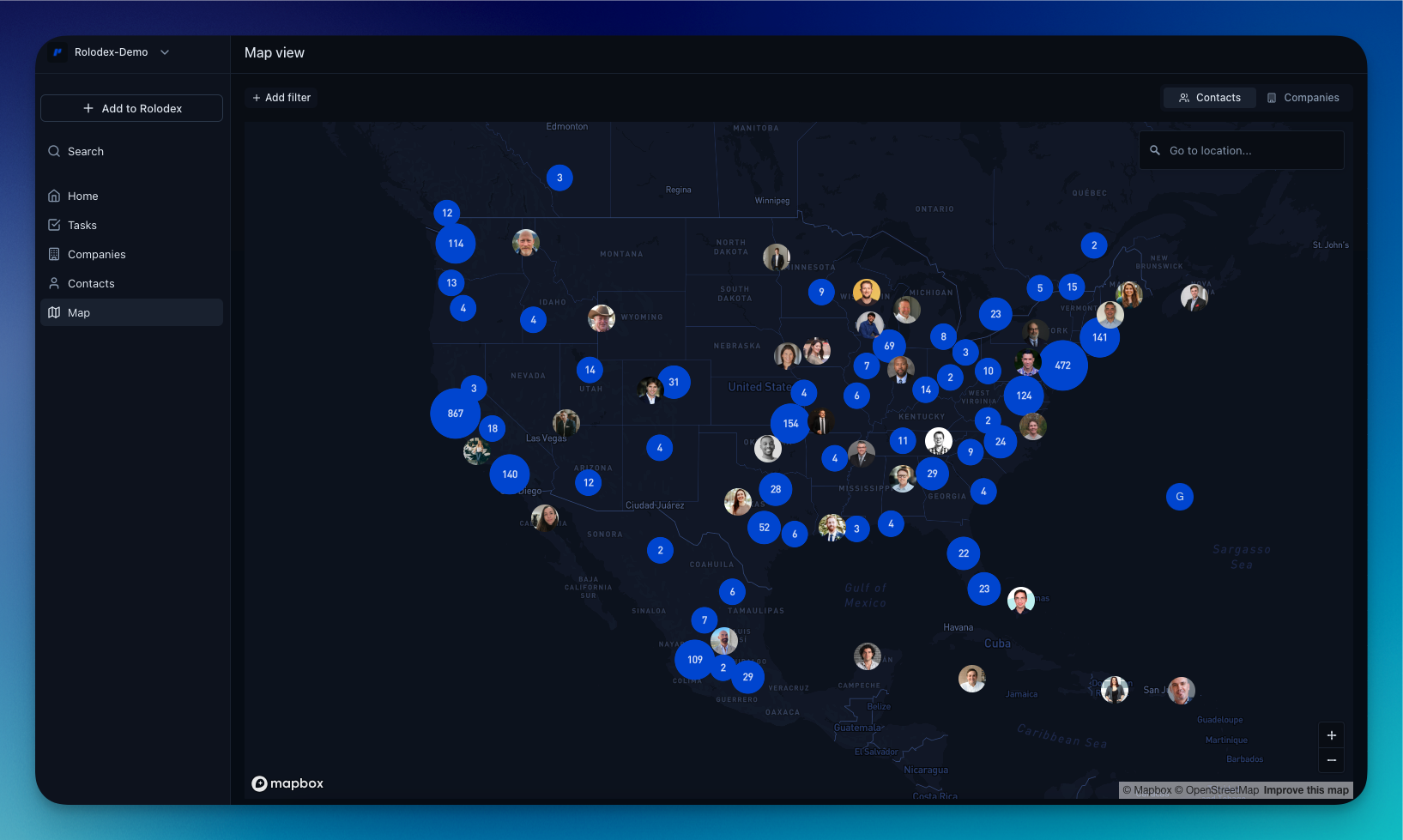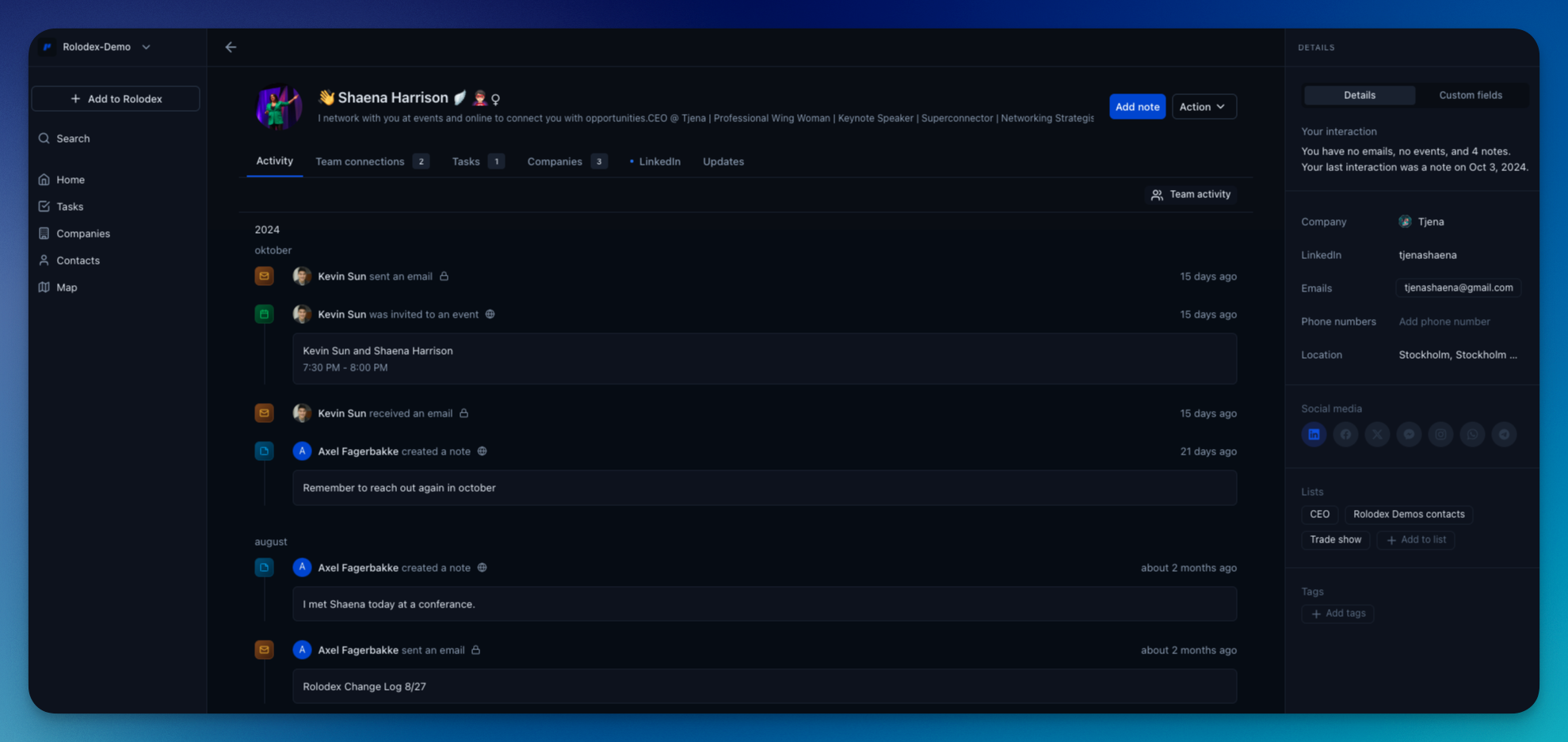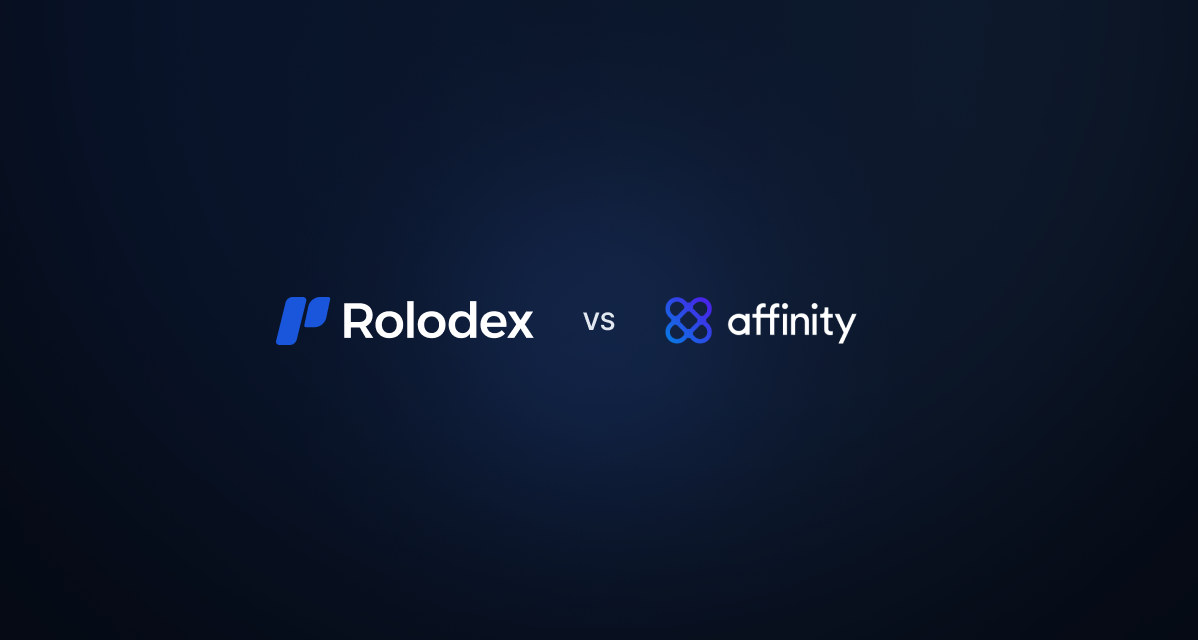There are many CRMs available, but if you're comparing Rolodex and Affinity, you're likely searching for a tool that goes beyond traditional CRMs. Both platforms offer unique approaches to relationship management for teams, but they cater to slightly different needs.
In this article, we’ll explore the key features and differences between Rolodex and Affinity to help you get the most out of your shared network.
Overview: Rolodex vs. Affinity
Both Rolodex and Affinity are powerful relationship management tools, focusing on people rather than pipelines—making them ideal for VCs, investors, consultants, and other relationship-driven teams.
However, key differences lie in their user experience, features, and, most notably, pricing.
Rolodex: Built for teams looking to prevent crossed wires and unlock the full potential of their shared network, Rolodex offers a streamlined, collaborative experience.
Affinity: Often used as a supplement for teams already leveraging Salesforce, Affinity can also function as a standalone CRM but is heavily geared toward private capital dealmaking.
Both platforms bring a lot to the table, but their unique strengths become clear when you dig deeper. Let’s explore these differences.
Comparison
Rolodex | Affinity | |
|---|---|---|
Ease of Use | Rolodex is designed with simplicity in mind, offering an intuitive user interface that requires minimal training. It’s built for teams looking for a straightforward, effective way to manage relationships without unnecessary complexity. | Affinity provides a feature-rich platform, but its complexity can overwhelm users, especially those unfamiliar with advanced CRMs. It’s better suited for teams with the time and resources to invest in mastering its functionality. |
Affordability | Rolodex is a cost-effective alternative, making it accessible to startups, small teams, and non-profits without sacrificing core features needed for effective relationship management. | Affinity’s pricing is premium and better suited for large enterprises or teams with bigger budgets, often making it less accessible to smaller organizations. |
Relationship Intelligence | Rolodex focuses on collaborative relationship intelligence, offering team-wide visibility into contacts, interactions, and updates from LinkedIn, Gmail, and Outlook. | Affinity excels in data-driven relationship insights, providing advanced analytics and reports for deep network analysis but requires significant setup and customization. |
Automate data capture and enrichment | Automatically syncs and updates data from LinkedIn, Gmail, and Outlook, giving teams real-time updates without manual input. Focused on making data capture seamless and accessible. | Automatically syncs and updates data from email and calendar. |
Automate Contact and Company Creation | Rolodex automatically adds contacts and companies from LinkedIn, email interactions and calendar events, streamlining setup for busy teams. | Create contact and company profiles directly from inbox and calendar data. |
Customization and Flexibility | Rolodex supports custom fields and flexible contact organization with tags and lists, making it easy to adapt to unique workflows without overcomplicating the platform. | Affinity offers powerful customization options but requires a steep learning curve to tailor it to your team’s specific needs. |
Send outgoing emails | Send emails directly from Rolodex with seamless integration to Gmail or Outlook. It’s perfect for quick, contextual communication without leaving the platform. | Reach out to clients and prospects without leaving your CRM |
Notifications | Stay on top of your network with smart notifications, including LinkedIn updates and reminders for key follow-ups, ensuring you never miss an opportunity. | Affinity provides notifications tied to pipeline activity and key updates but may feel overly focused on deal-centric workflows rather than broader relationship management. |
Accessibility for Teams of Any Size | Rolodex is designed for scalability, catering to both small teams and growing organizations with its flexible pricing and features. | Affinity’s robust features make it ideal for larger teams or enterprise users, but its complexity and price point can be a barrier for smaller teams or startups. |
Key differences between Rolodex and Affinity
1. Ease of use
Rolodex: Rolodex is designed with simplicity at its core, offering an intuitive user experience that makes onboarding seamless. Its streamlined features focus on what teams need most: managing contacts, companies, and interactions without unnecessary complexity. Rolodex avoids the pitfalls of overloading users with countless integrations, keeping the tool efficient and easy to navigate.
Affinity: While powerful, Affinity’s broad array of features and integrations adds complexity, making it harder for teams to adopt quickly. Its capabilities often cater to advanced use cases, requiring significant time and effort to configure and learn. For organizations that don’t need extensive integrations or analytics, Affinity may feel like overkill.
2. Affordability
Rolodex: Offering a cost-effective solution, Rolodex provides all the essential features for relationship intelligence at a much lower price point than Affinity. It’s ideal for startups, non-profits, and small to medium-sized businesses. Rolodex is also well-suited for VC firms, providing them with tools to manage and nurture relationships without breaking the bank. This affordability ensures teams can focus on growing their networks without the financial strain of more expensive platforms.
Affinity: As a premium product, Affinity’s pricing reflects its advanced features and integrations. However, this higher cost might not justify its value for teams primarily focused on managing relationships rather than leveraging deal pipelines or analytics-heavy tools.
3. Relationship Intelligence Features
Rolodex: Rolodex stands out with its LinkedIn integration, enabling teams to sync their networks, track title changes, and stay updated on professional moves directly within the platform. This feature provides unparalleled visibility into your team’s relationships. Rolodex also includes a map view, allowing teams to visualize where their contacts are located—a valuable tool for planning in-person meetings or events. These features empower teams to build deeper, more meaningful connections.
Affinity: While Affinity excels in relationship intelligence, it lacks LinkedIn integration, limiting insights into the dynamic changes within professional networks. While it offers analytics and relationship strength scoring, it doesn’t provide tools like a map view, leaving gaps in visualizing and leveraging team networks comprehensively.

Which offer More Value?
Pricing is often a critical factor when choosing the right relationship management tool for your team.
Rolodex: Available at a starting price of $29 per user per month, billed annually. This plan includes core features such as LinkedIn integration, email and calendar sync, shared workspaces, customizable fields, tasks, and a map view. Rolodex focuses on delivering essential relationship intelligence tools in a simple, user-friendly platform, making it ideal for teams that want to collaborate without dealing with the complexities of traditional CRM systems.
Affinity: Starts at $166 per user per month for its most affordable plan, which gives you core features like relationship and network management, automated contact creation, activity capture and dealflow management. To access all of Affinitys features you will have to pay $225 per user per month.
While Affinity offers robust capabilities tailored for venture capital and private equity, its advanced features—such as predefined pipelines and relationship strength scoring—may not be necessary for teams simply looking to organize their networks and streamline relationship tracking. Additionally, Affinity often works best as an enhancement to existing CRMs like Salesforce, adding to its overall cost.
If you’re looking for an affordable, intuitive tool that delivers the core functionality you need—without the extra cost of features you might not use—Rolodex offers more value for the majority of teams. For organizations with specialized deal management needs, Affinity’s higher price may be worth considering, but it comes at a premium that isn’t always justified for simpler use cases.

Who should use Rolodex?
Rolodex is perfect if:
You want a straightforward, easy-to-use platform to manage and share your team’s network.
You prioritize LinkedIn integration to track updates like title changes and network activity.
You need a cost-effective solution that provides essential relationship intelligence without complex pipelines.
You value tools that support collaboration, such as shared workspaces, customizable fields, and task management.
You’re part of a small to mid-sized team, VC, consultancy, or nonprofit looking for an intuitive tool to manage relationships.
If you’re looking for a tool that keeps your team aligned without overwhelming you with unnecessary features, Rolodex is the ideal choice.
Who should use Affinity?
Affinity might be better for your team if:
You already use Salesforce and need Affinity to enhance data and integrations.
You manage highly structured workflows requiring predefined pipelines and templates.
However, if you’re looking for a simpler, more affordable way to track your team’s shared network and interactions without relying on sales-focused tools, Rolodex may be the better fit.
Comparison as a Relationship Management tool
Feature | Rolodex | Affinity | |
|---|---|---|---|
Email Sync | ✅ | ✅ | Both products automatically sync contacts from your email. |
Calendar Sync | ✅ | ✅ | Both products automatically sync events from your calendar. |
LinkedIn sync | ✅ | ❌ | Rolodex enhances your network with LinkedIn data, allowing you to view your team’s LinkedIn connections directly in the CRM. |
Interaction History | ✅ | ✅ | Both provide a complete history of communications. |
Activity Timeline | ✅ | ✅ | Both offer a timeline of activities for your contacts. |
Relationship strength | 🔜 | ✅ | Affinity uses AI to score the strength of relationships. Rolodex plans to introduce this feature soon. |
Create lists | ✅ | ✅ | Create custom lists for contacts, companies, or opportunities, tailored to your team’s workflow. |
Add notes | ✅ | ✅ | Both allow notes to be added to contacts and companies, with options to create shared or individual notes. |
Tag in notes | ✅ | ✅ | Tag teammates in notes to foster collaboration. |
Tasks | ✅ | ❌ | Rolodex enables task creation for teammates on contacts or companies within your shared network. |
Choose privacy level | ✅ | ✅ | Both allow you to control the level of email and meeting content shared, from full details to metadata only. |
Upload files and attach to contacts | 🔜 | ✅ | Affinity allows attaching files like pitch decks to contacts. Rolodex is working on adding this feature. |
Notification: New contacts added | ✅ | ❌ | Rolodex notifies you of all new contacts added to your network daily. |
Notification: Title Changes and Updates | ✅ | ❌ | Rolodex provides daily updates on network changes, such as LinkedIn title updates and status changes. |
Board View | 🔜 | ✅ | Affinity offers predefined views for deal flow; Rolodex is developing customizable board views. |
Team Connections | ✅ | ✅ | Both products show who on your team is connected to a contact or company. |
Key Differences:
LinkedIn integration: Rolodex stands out with its LinkedIn sync, which Affinity lacks, providing deeper insights into your network.
Task Management: Only Rolodex supports creating and assigning tasks within your shared network
Notifications: Rolodex delivers unique notifications about network changes and new connections, helping you stay proactive.
Affordability: Rolodex offers a streamlined experience at a lower price point compared to Affinity’s more feature-rich (and expensive) plans.

Final Thoughts
Choosing between Rolodex and Affinity ultimately comes down to your team’s specific needs and priorities. If you’re looking for a straightforward, cost-effective solution that focuses on relationship intelligence and collaboration, Rolodex offers all the core features you need without unnecessary complexity. On the other hand, if your team operates heavily in deal management and requires advanced analytics and predefined workflows, Affinity might be a better fit—though at a higher price point.
At the end of the day, the best one is the one that has all your desired features and easily integrates into your workflow. Try Rolodex and see how it fits into your workflow—you might just find it’s the tool you’ve been looking for.
